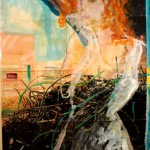For several years now I have had the pleasure of watching the evolution of Kim Celona’s work as a visual artist. I first started to follow Kim’s work when she was a graduate student and it is fascinating to see how some things about her work have changed, while others have remained the same. Always a great technician, her paintings and collage work have become looser and more organic. There is a much more assured quality to her brushstroke. Yet her engagement with nature and with particularly an elusive young woman in her paintings, have remained continual preoccupations. When I saw the latest body of Kim’s work, “Purveying Beauty”, I knew the time had come to sit down and talk to her about the various ways in which she saw the major bodies of mainly paintings that she has completed thus far referencing and speaking to one another.
Kim, explain to our readers the series you are currently working on “Purveying Beauty.” What is this series all about? What are you trying to communicate to your viewer in these works? 
“Purveying Beauty” is a body of work exploring the concept of beauty and aesthetics, mainly derived from nature. I’ve been capturing these moments with photography and that was the original template for this idea. Even though “Purveying Beauty” began as a series of photographs, I started to get the sense that other materials were becoming necessary for me to express my ideas fully. And so I began thinking about layering the work.
What do you mean by layering the work?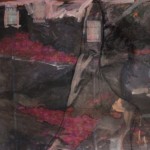
It’s a very intuitive and spontaneous process. In layering I use photography as a base, the foundation from which I build the work. The photograph serves as the core of my idea. Sometimes I will draw or write with charcoal, then apply paint over parts of the photograph. Other times I embellish the photograph with mica powders or powdered pigments that I mix with resin. Sometimes I add natural elements like shells or branches. Also, from time to time, I will tear part of the photo or not transfer the whole thing. Some parts I will purposely partially cover. If I work with resins and powder pigments, I will physically turn and move the canvas or board to manipulate the image until I get the desired effect. This is what I mean by layering. The layers help form different facets of my concept or message. The materials and the process of layering physically and emotionally convey depth and mystery. The work becomes an entity of its own. Each layer has something to add to the meaning of the image. It’s like a conversation. Every word is hinged upon the next, each idea presented as part of the whole conversation.
Have you used layering in your work before?
Yes. Layering is a reoccurring theme in my work. I like working in layers because, in so doing, I can both conceal and reveal visual information with additive and subtractive methods. It also makes the viewer work a little because it challenges them to really look at what they are seeing, and I like that. Obviously, as artists, our initial impetus is self-expression but as well we need to communicate with others and the way that we choose to communicate is with our materials and the content of the work itself. “Purveying Beauty” is communicating the idea of beauty and the sources it can be derived from. 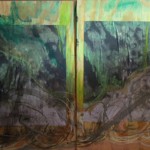 By beauty, I do not only mean a surface presentation of beauty, but inner as well as outer beauty. The work is a conversation about how we interpret beauty and how it engages all our senses.
By beauty, I do not only mean a surface presentation of beauty, but inner as well as outer beauty. The work is a conversation about how we interpret beauty and how it engages all our senses.  Viewing elements of beauty does something significant to the human psyche. It engages us on so many levels, providing meaning, helping us to discover strength, love and spirituality in our lives. It strikes the core of our being and makes us feel something significant, something real and good. We always walk away with a renewed sense of wonder after we have been engaged with something beautiful.
Viewing elements of beauty does something significant to the human psyche. It engages us on so many levels, providing meaning, helping us to discover strength, love and spirituality in our lives. It strikes the core of our being and makes us feel something significant, something real and good. We always walk away with a renewed sense of wonder after we have been engaged with something beautiful.
How does this series connect to your other bodies of work “Meditations” and “Divine Providence”?
All my work is interconnected. My life and art do not work in fragments, in closed loops, stops and starts. I see both my art and life as a continuous line. One event or series is always hinged onto another. “Divine Providence” is the point where I began working in layers, with photography, resins and mixed media. It was also the juncture where I began to see my art as a very critical way of finding and discovering myself. As well, “Divine Providence” contains very spiritual overtones. “Meditations” is a continuation of “Divine Providence” in the sense of process and the spiritual element. There is a transcendence in “Meditations” which was not necessarily a strong element in “Divine Providence.” In “Divine Providence” the physical world was navigated but in “Meditations” there was a very otherworldly, spiritual, mysterious and internal world, which came into fruition. This world of mystery and intrigue carried over into “Purveying Beauty.”
In addition to being a visual artist you are also a writer. What came first for you or did the two art forms develop simultaneously? How do the two art forms inform each other?
It depends on how far back you’d like to go. If I was to go back to childhood, I’d say the visual was more evident because this was my primary means of interpreting the world. I’d sit and draw for hours on end. Time stood still. Once I was in high school, I had a phenomenal English teacher who really engaged and inspired me to express myself with words. I then began keeping sketchbooks and journals. 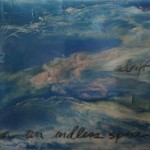 Sketchbooks and journals both remain different ways to interpret and understand concepts, however the thought of both working in unison didn’t occur to me until probably college, at Parsons School of Design, where once again, a great teacher showed me the way — or a way — to bring both art forms together. This was through the writing and illustration of children’s books. I’m actually involved
Sketchbooks and journals both remain different ways to interpret and understand concepts, however the thought of both working in unison didn’t occur to me until probably college, at Parsons School of Design, where once again, a great teacher showed me the way — or a way — to bring both art forms together. This was through the writing and illustration of children’s books. I’m actually involved 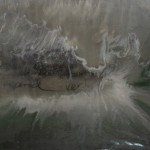 again and working on a children’s book, with my daughter Anya. Reading was and is a critical part of how I learn. I’ve always loved to read. Reading. Drawing. Reading. Drawing. That was the pattern and still is a pattern of my life. Throughout my career I have found that I am drawn to combining art and writing. I am still on a quest to discover the millions of ways I can explore them both.
again and working on a children’s book, with my daughter Anya. Reading was and is a critical part of how I learn. I’ve always loved to read. Reading. Drawing. Reading. Drawing. That was the pattern and still is a pattern of my life. Throughout my career I have found that I am drawn to combining art and writing. I am still on a quest to discover the millions of ways I can explore them both.
In addition to nature, the theme that stands out most strongly for me about your work is the presence of what I would call a wistful young woman at the center of your paintings. What can you tell us about who this elusive mysterious woman is?
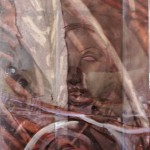 I’ve heard and definitely read before that every painting an artist creates is in fact a self portrait. With that said, the woman in the paintings is me. She is me in my weakest and strongest moments. She is me... past, present, future. She is me even when she is not present in my work. She is there in every brushstroke, every drip of paint, every layer of media, she manages to inhabit every inch of my art. I read recently a very fascinating book called “The Mona Lisa Stratagem” by Harriet Rubin. In discussing the Mona Lisa she writes, “...we sense the figure before us is not one woman but is the reflection of many faces, many epochs. She is born an “I” but becomes a “we”- all women. She is a time traveler too. She is old, young, eternal.” Similarly, in my work, this elusive woman can be found in any space, place or time. I think because of this quality, she seems to project, evoke, invite an aura of intrigue and mystery.
I’ve heard and definitely read before that every painting an artist creates is in fact a self portrait. With that said, the woman in the paintings is me. She is me in my weakest and strongest moments. She is me... past, present, future. She is me even when she is not present in my work. She is there in every brushstroke, every drip of paint, every layer of media, she manages to inhabit every inch of my art. I read recently a very fascinating book called “The Mona Lisa Stratagem” by Harriet Rubin. In discussing the Mona Lisa she writes, “...we sense the figure before us is not one woman but is the reflection of many faces, many epochs. She is born an “I” but becomes a “we”- all women. She is a time traveler too. She is old, young, eternal.” Similarly, in my work, this elusive woman can be found in any space, place or time. I think because of this quality, she seems to project, evoke, invite an aura of intrigue and mystery. 
